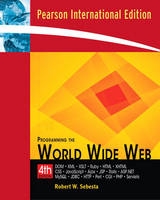
Programming the World Wide Web
Pearson (Verlag)
978-0-321-31257-0 (ISBN)
- Titel erscheint in neuer Auflage
- Artikel merken
Programming the World Wide Web provides a comprehensive introduction to the programming tools and skills required for building and maintaining server sites on the Web, as well as teaching students how to develop platform-independent sites. It takes a holistic approach, and readers are guided through concepts relating to client-side and server-side programming including ASP.NET using C#, Javascript, java servlets, JSP, Perl/CGI Java Applets, XHTML and XML. This book is intended for readers who have experience programming with an object-oriented language.
1Fundamentals
1.1 A Brief Introduction to the Internet
1.2 The World Wide Web
1.3 Web Browsers
1.4 Web Servers
1.5 Uniform Resource Locators
1.6 Multipurpose Internet Mail Extensions
1.7 The Hypertext Transfer Protocol
1.8 The Web Programmer’s Toolbox
1.9 Summary
1.10 Review Questions
1.11 Exercises
2Introduction to XHTML
2.1 Origins and Evolution of HTML and XHTML
2.2 Basic Syntax
2.3 Standard XHTML Document Structure
2.4 Basic Text Formatting
2.5 Images
2.6 Hypertext Links
2.7 Lists
2.8 Tables
2.9 Forms
2.10 Frames
2.11 Summary
2.12 Review Questions
2.13 Exercises
3Cascading Style Sheets
3.1 Introduction
3.2 Levels of Style Sheets
3.3 Style Specification Formats
3.4 Selector Formats
3.5 Property Value Forms
3.6 Font Properties
3.7 List Properties
3.8 Alignment of Text
3.9 Margins
3.10 Color
3.11 Background Images
3.12 Borders
3.13 The and Tags
3.14 Summary
3.15 Review Questions
3.16 Exercises
4The Basics of JavaScript
4.1 Overview of JavaScript
4.2 Object Orientation and JavaScript
4.3 General Syntactic Characteristics
4.4 Primitives, Operations, and Expressions
4.5 Screen Output and Keyboard Input
4.6 Control Statements
4.7 Object Creation and Modification
4.8 Arrays
4.9 Functions
4.10 An Example
4.11 Constructors
4.12 Pattern Matching Using Regular Expressions
4.13 Another Example
4.14 Errors in Scripts
4.15 Summary
4.16 Review Questions
4.17 Exercises
5JavaScript and HTML Documents
5.1 The JavaScript Execution Environment
5.2 The Document Object Model
5.3 Element Access in JavaScript
5.4 Events and Event Handling
5.5 Handling Events from Body Elements
5.6 Handling Events from Button Elements
5.7 Handling Events from Text Boxes and Passwords
5.8 The DOM 2 Event Model
5.9 The navigator Object
5.10 Summary
5.11 Review Questions
5.12 Exercises
6Dynamic Documents with JavaScript
6.1 Introduction
6.2 Element Positioning
6.3 Moving Elements
6.4 Element Visibility
6.5 Changing Colors and Fonts
6.6 Dynamic Content
6.7 Stacking Elements
6.8 Locating the Mouse Cursor
6.9 Reacting to a Mouse Click
6.10 Slow Movement of Elements
6.11 Dragging and Dropping Elements
6.12 Summary
6.13 Review Questions
6.14 Exercises
7Java Applets
7.1 Introduction
7.2 The Primary Applet Activities
7.3 The paintComponent Method
7.4 The 7.5 Applet Parameters
7.6 Simple Graphics
7.7 Color
7.8 Interactive Applets
7.9 Summary
7.10 Review Questions
7.11 Exercises
8Introduction to XML
8.1 Introduction
8.2 The Syntax of XML
8.3 XML Document Structure
8.4 Document Type Definitions
8.5 Namespaces
8.6 XML Schemas
8.7 Displaying Raw XML Documents
8.8 Displaying XML Documents with CSS
8.9 XSLT Style Sheets
8.10 XML Processors
8.11 Summary
8.12 Review Questions
8.13 Exercises
9The Basics of Perl
9.1 Origins and Uses of Perl
9.2 Scalars and Their Operations
9.3 Assignment Statements and Simple Input and Output
9.4 Control Statements
9.5 Fundamentals of Arrays
9.6 Hashes
9.7 References
9.8 Functions
9.9 Pattern Matching
9.10 File Input and Output
9.11 An Example
9.12 Summary
9.13 Review Questions
9.14 Exercises
10Using Perl for CGI Programming
10.1 The Common Gateway Interface
10.2 CGI Linkage
10.3 Query String Format
10.4 The CGI.pm Module
10.5 A Survey Example
10.6 Cookies
10.7 Summary
10.8 Review Questions
10.9 Exercises
11Servlets and Java Server Pages
11.1 Overview of Servlets
11.2 Servlet Details
11.3 A Survey Example
11.4 Storing Information on Clients
11.5 Java Server Pages
11.6 Summary
11.7 Review Questions
11.8 Exercises
12Introduction to PHP
12.1 Origins and Uses of PHP
12.2 Overview of PHP
12.3 General Syntactic Characteristics
12.4 Primitives, Operations, and Expressions
12.5 Output
12.6 Control Statements
12.7 Arrays
12.8 Functions
12.9 Pattern Matching
12.10 Form Handling
12.11 Files
12.12 Cookies
12.13 Session Tracking
12.14 Summary
12.15 Review Questions
12.16 Exercises
13Introduction to ASP.NET
13.1 Overview of the .NET Framework
13.2 Overview of C#
13.3 Introduction to ASP.NET
13.4 ASP.NET Controls
13.5 Summary
13.6 Review Questions
13.7 Exercises
14Database Access through the Web
14.1 Relational Databases
14.2 An Introduction to the Structured Query Language
14.3 Architectures for Database Access
14.4 The MySQL Database System
14.5 Database Access with Perl and MySQL
14.6 Database Access with PHP and MySQL
14.7 Database Access with JDBC and MySQL
14.8 Summary
14.9 Review Questions
14.10 Exercises
Appendix AIntroduction to Java
A.1 Overview of Java
A.2 Data Types and Structures
A.3 Classes, Objects, and Methods
A.4 Interfaces
A.5 Exception Handling
A.6 Summary
Index
| Erscheint lt. Verlag | 14.6.2005 |
|---|---|
| Sprache | englisch |
| Maße | 188 x 230 mm |
| Gewicht | 980 g |
| Themenwelt | Mathematik / Informatik ► Informatik ► Grafik / Design |
| Mathematik / Informatik ► Informatik ► Web / Internet | |
| ISBN-10 | 0-321-31257-0 / 0321312570 |
| ISBN-13 | 978-0-321-31257-0 / 9780321312570 |
| Zustand | Neuware |
| Haben Sie eine Frage zum Produkt? |
aus dem Bereich



